Psychoenergetics
The Journal of Psychophysical Systems
Edited by D. F. Lawden, Mathematics Department, University of Aston in Birmingham, England.
Consulting Editors:
V. Adamenko (U.S.S.R.); E.W. Bastin (U.K.); J. Beloff (U.K.); H. Bender (W. Germany); O. Costa de Beauregard (France); A.J. Ellison (U.K.); A. Gregory (U.K.); E. Harris Walker (U.S.A.); J.B. Hasted (U.K.); B. Herbert (U.K.); B.D. Josephson (U.K.); S. Krippner (U.S.A.); P. Maddock (U.K.); J. Miklos (Romania); H. Schmidt (U.S.A.); E. Servadio (Italy); C. Tart (U.S.A.); J. Taylor (U.K.).
The journal will publish original selected papers in English describing contemporary research into the behaviour of psychophysical systems. A psychophysical system is defined to be any assembly of elements whose behaviour cannot be explained by appeal to the known physical modes of interaction and where the presence of mind or consciousness or other psychic factors within the system, suggests the existence of an additional psychic mode of interaction between its elements. Theoretical papers proposing mathematical models for such hypothetical psychophysical interactions will be particularly welcome for consideration, but accounts of experimental or other scientific investigations of psychic phenomena are also invited. Occasional commissioned articles surveying the current state of knowledge over a restricted field will be published. All papers submitted will be refereed by one of the consulting editors or by other authorities appointed by the Editor.
Each volume of the Journal will be published in four separate parts at intervals regulated by the supply of acceptable papers.
Short contributions containing criticisms of or footnotes to already published papers, or progress reports on research currently being conducted, will be collected in a special section and will be given priority over other material. There will also be a Book Reviews section.
Psychoenergetics, 1983, Vol. 5, pp. 99-128
0278-6060/83/0502-0099 $18.50
Gordon and Breach Science Publishers, Inc., 1983
Printed in the United Kingdom
Observations on selected Italian mini – Gellers
F.BERSANI
Istituto di Fisica, Università di Bologna, Direttore scientifico del Centro Studi Parapsicologici (CSP) di Bologna, Italy.
and
A. MARTELLI
Istituto di Chimica pharmaceutica, Università di Torino, Membro del Centro Studi Parapsicologici (CSP) di Bologna, Italy.
During the years 1975-78, we investigated a selected number of youngsters (four boys and one girl) who claimed to be able to bend metal objects, after watching TV performances of U. Geller or of his imitators. We performed 194 planned experiments with these subjects, and during our investigation we witnessed 32 spontaneous events. The effects observed range from the typical bending of metal objects such as spoons, keys, bars, etc. to strange effects like light-flashes and teleportation. The most significant experiments were carried out with samples within sealed containers. The metal bending events were in some instances recorded by means of resistive strain gauges. In spite of the lack of an absolutely ‘crucial result’, we have collected evidence in favour of genuine paranormal phenomena actually taking place. We submitted our results to a critical evaluation, and we also consulted two professional magicians as experts on the feasibility of fraud.
1. EXPERIMENTAL PROGRAMME
During the years 1975-78 we carried out extensive experimentation on a selected group of local ‘mini-Gellers’ whose ability to perform metal bending had been brought to the attention of the Bologna Centro Studi Parapsicologi (CSP) by their relatives and acquaintances.
Relative to other experimenters (e.g. Hasted, 1976, 1977, 1980, Isaacs, 1981, Taylor, 1975), we have investigated a smaller selection of individuals (five youngsters), but we have focussed our attention not only on the phenomena as such but also on the environment in which they took place. The subjects were four boys and one girl: Paride Giatti, aged 10, second child of a farmer’s family of five children, having one twin brother; Sandro Gasperini, aged 10, the last of three boys; Lucia Allegretti, aged 9 1/2, the oldest of three girls; Orlando Bragante, aged 14, an only child, fatherless since the age of four, and Giovanni d’Emilio, aged 7 1/2, the second of two boys. Everybody in the group had developed his (or her) abilities as a consequence of watching on television either Uri Geller or some of his imitators, including a magician who simulated metal bending experiments.
With these children, we performed 194 planned experiments (PE), and during our investigations we witnessed 32 spontaneous events (SE). For each trial, a rough reliability scale was drawn up. The grades were + = poor, ++ = uncertain, and +++ = good. This scale, of course, was not applied to results which were clearly the outcome of tricks, of which a separate account was made, nor to negative results, which were also subject to a separate analysis.
It goes without saying that every test presupposed the honesty of the experimenter, which guaranteed that the procedure applied was exactly as described. The crucial nature of a test should depend upon the protocol structure of the experiment, rather than on the subjective verification of the phenomenon.
In the series of trials we carried out, we encountered a number of difficulties in obtaining a crucial test proper. Indeed, very often during experiments, some planned conditions of reliability proved to be missing at some point. Nevertheless, some experiments were conducted under very satisfactory control conditions.
The experiments were occasionally performed in ad hoc circumstances, but generally they were carefully planned in advance. Among the goals of the investigation were the following three: (i) the assessment of the physical conditions characterizing the phenomena; (ii) the assessment of the psychological state of the subject during the phenomena and the clarification of the circumstances under which the phenomena occurred; (iii) the monitoring of the physiological states of the subjects. Many of the preprogrammed tests did not take place. In particular, goal (iii) could not be pursued to any significant extent due to the reluctance of the subjects to undergo physiological tests (such as E.E.G.). (ii) will be extensively discussed in another publication.
The trials graded poor (+) do not merit detailed discussion (although they are part of the overall experimental context); on the other hand, we think it would be improper to reject those graded uncertain (++), which could comprise genuine paranormal phenomena. Clearly, the most significant results from the point of view of research are the ones graded good (+++).
As we mentioned before, we observed a total of 226 phenomena, which were classified into eight groups, depending on the type of supposed P.K. effect occurring, and on the material involved, as follows:
(1) Bending or fracture of metal tableware, keys, clips, safety pins, rings, etc., with direct physical contact, such as stroking.
(2) Bending or fracture of metal objects, both in the open and within sealed containers, without any direct physical contact. The enclosing material was either cardboard, polyethylene, plexiglass, or other plastic material, or glass.
(3) Bending or fracture of non-metallic objects (wood, plastics, glass) both in the open and within sealed containers.
(4) Phenomena involving light bulbs and fluorescent tubes (flashing, fracture, and explosion).
(5) Telekinesis phenomena with metallic or non-metallic objects.
(6) Thermal effects.
(7) Teleportation.
(8) Miscellaneous effects, such as interference with pace-makers, infra-red beams, spectrophotometers, photographic plates, etc.
Table I summarizes the data relative to all the experiments performed by the experimenters.
Because it is difficult to summarize in a single paper a comprehensive description of the experiments done, in the following section we will describe a limited number of experiments, chosen from among the most significant ones in terms of the conditions under which they were performed and of the results obtained. We will devote another paper to a detailed discussion of a few negative and/or suspicious results and to the general problem of validation in this kind of investigation. The experiments reported here involved P. Giatti, O. Bragante and S. Gasperini.
The most gifted and the most extensively studied subject was O. Bragante. He first started bending spoons and forks 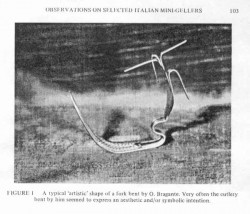 and developed in the following months a wide range of phenomena, including light flashing, teleportation and some spontaneous effects very similar to RSPK phenomena. In Figure 1, a typical metal bending effect performed by him is shown.
and developed in the following months a wide range of phenomena, including light flashing, teleportation and some spontaneous effects very similar to RSPK phenomena. In Figure 1, a typical metal bending effect performed by him is shown.
In spite of the great number of experiments and observations made by us, the phenomena were not very frequent, and generally did not seem to occur under strictly voluntary control. As far as the awareness of what was going on is concerned, for the major part of the planned experiments the subjects seemed conscious of their goal, but in some instances, especially for some spontaneous events, the phenomena appeared to override their intentions and to acquire some characteristics of RSPK.
TABLE 1
Classification of the results of the experiments
| TNP | PE | SE | TR | + | ++ | +++ | NR | ||
| 226 | 194 | 32 | 3 | 61 | 61 | 31 | 70 |
| PE | NR | PR | PR | + | ++ | +++ | TR | ||
| 194 | 70 | 124 | 124 | 36 | 58 | 28 | 2 |
| Group 1 | 2a | 3 | 4 | 5 | 6 | 7 | 8 | |
| PE | 45 | 89=28+61 | 11 | 8 | 10 | 3 | 17 | 11 |
| PR | 37 | 52=14+38 | 5 | 8 | 7 | 2 | 10 | 3 |
| + | 10 | 16=7+9 | 1 | 2 | 3 | 1 | 3 | – |
| ++ | 27 | 15=3+12 | 1 | 3 | 3 | – | 6 | 3 |
| +++ | – | 20=4+16 | 2 | 3 | 1 | 1 | 1 | – |
| Tr | – | 1 | 1 | – | – | – | – | – |
| TNP +++ |
PE | SE | A | B | C | D | E | F |
| 31= | 28+ | 3 | 4+1 | 3+1 | 1+0 | 4+1 | 5+0 | 11+0 |
| TNP | Total number of phenomena, not all occurring in the presence of the experimenter. | |||||||
| PE | Planned experiments | |||||||
| SE | Spontaneous events | |||||||
| Tr | Tricks (declared or suspected) | |||||||
| + | Poor reliability | |||||||
| ++ | Uncertain reliability | |||||||
| +++ | Good reliability | |||||||
| NR | Negative results | |||||||
| PR | Positive results (here the term “positive” merely refers to the correspondence between the demand and result, irrespective of possible fraud). | |||||||
| a | The first figure refers to the total number of trials, the second to the number of trials with objects in the open, and the third to the number of trials with sealed objects | |||||||
| A | Type 4 Phenomena | |||||||
| B | Thermic phenomena | |||||||
| C | Transfer phenomena | |||||||
| D | Bending phenomena of objects not enclosed in containers | |||||||
| E | Bending phenomena of objects enclosed in soft container | |||||||
| F | Action on objects closed in rigid containers | |||||||
2. DESCRIPTIONS OF EXPERIMENTS
Experiment No. 1:Subject: Paride Giatti (PE No. 9)
A puppet having a copper core (2mm in diameter) covered by coloured putty, was placed in a sealed plexiglass 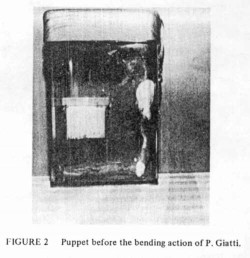 container, where it was sitting on the bottom, with the arms lying along its body and the legs making a 90 degree angle with the trunk (Figure 2). The box was 70 X 70 X 110mm. Over the imitation wood plastic lid, a band of canvas was placed, and was secured by means of two seals at the top of the lid and on two opposite sides of the box. The seals were formed by melting sealing wax and were given an original impression.
container, where it was sitting on the bottom, with the arms lying along its body and the legs making a 90 degree angle with the trunk (Figure 2). The box was 70 X 70 X 110mm. Over the imitation wood plastic lid, a band of canvas was placed, and was secured by means of two seals at the top of the lid and on two opposite sides of the box. The seals were formed by melting sealing wax and were given an original impression.
In order to check any motion that the child could have brought about by ordinary physical means, the following device was used: A small covered cylindrical plastic container (50mm X 30mm), containing two finely subdivided materials of different colours in superimposed layers, with a small empty space at the top to permit mixing, was fixed inside the box by means of putty. Such a method was often utilized in the course of experiments involving sealed containers, since it provided a sort of self-guarantee that allowed the experimenters not to be present all the time.
The choice of the puppet was intended to provide the child with some emotional involvement with the object itself, 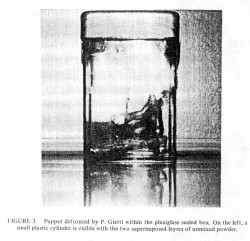 with which he could to some extent identify and which he could try to animate. The aim of the experiment was to determine whether PK capacities were ‘addressable’, i.e. whether they could be directed toward a precise target, such as the arms or the head of the puppet. The box was left with the boy in his home for thirteen days, after which time he returned it, with the seals intact, and the control cylinder materials unmixed. The arms of the puppet were rotated upwards at a right angle to the trunk which in turn was slightly bent down, while the head was upturned (Figure 3).
with which he could to some extent identify and which he could try to animate. The aim of the experiment was to determine whether PK capacities were ‘addressable’, i.e. whether they could be directed toward a precise target, such as the arms or the head of the puppet. The box was left with the boy in his home for thirteen days, after which time he returned it, with the seals intact, and the control cylinder materials unmixed. The arms of the puppet were rotated upwards at a right angle to the trunk which in turn was slightly bent down, while the head was upturned (Figure 3).
The subject said he had had the intention of getting the puppet to perform ‘Hitler’s salute’ and his father reported that the deformation had taken place in two steps; first, the head and one arm were bent, then the other arm followed. In both cases the boy had operated while in a room all by himself.
If we allow for the possible authenticity of the phenomenon, since it seems unlikely that the boy could have counterfeited the seals, it appears that in this instance the subject has succeeded in ‘addressing’ the action.
Magicians’ Opinions
Magician A: The experiment seemed to provide a good test. However, he felt uneasy about the box remaining for a long time in the boy’s house.
Magician V.B.: He had doubts about the effectiveness of the cylinder control device, although he could not be specific in regard to his doubts on the matter. He thought that the sample could have been counterfeited by taking the seals off the box and gluing them to a new box (without touching the lid) or that the original seals could have been imitated.
Experiment No. 2: Subject: Sandro Gasperini (PE No. 30)
The set task involved a material other than metal, viz. a rigid plexiglass spatula (3cm) which was coated with an 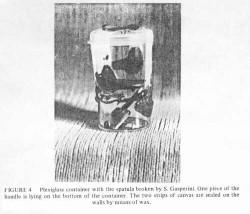 aluminium paint and enclosed in a plexiglass cylindrical box (see Figure 4). The size of the box was 50mm X 30mm. The lid was of semi-rigid plastic material, closed with two strips of material sealed to the sides by means of sealing wax with an original impression. In addition to the impressions on the seals, the unique gutter of the wax on the strips was used as a control against manipulation.
aluminium paint and enclosed in a plexiglass cylindrical box (see Figure 4). The size of the box was 50mm X 30mm. The lid was of semi-rigid plastic material, closed with two strips of material sealed to the sides by means of sealing wax with an original impression. In addition to the impressions on the seals, the unique gutter of the wax on the strips was used as a control against manipulation.
The idea behind the aluminium coating of the spatula was to make it more acceptable to the subject who was accustomed to dealing with metallic objects. The sample was left with the boy for ten days and was returned with the seals intact and with the rod broken. The container was undamaged.
Instead of bending as requested, the spatula had broken, in accordance with the characteristics of the material employed. The fracture had occurred at one third of the distance along the free handle portion and there were paint chips on the container walls. This detail is very significant since the effect, which was unpredictable for the subject who was unaware of the true nature of the spatula, demonstrated the fact that the fracture had taken place suddenly inside the box.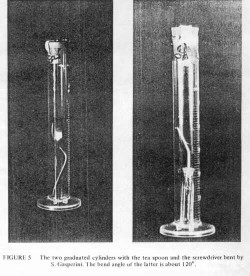
A number of checks demonstrated that the spatula could not be broken by shaking the box. Moreover, the fracture was clean, without any smoothing effects such as thermal effects, and seemed of mechanical origin.
In conditions very similar to those described above, the subject also obtained a bending effect on two samples enclosed inside two plexiglass graduated cylinders (100ml). The cylinders were typical chemistry laboratory accessories. Each cylinder was closed by means of a rubber stopper, sealed with a strip of canvas and two wax seals. The inserted portion of the stopper was such as to make extremely difficult any external manipulation of the same without breaking the seals. The first cylinder contained a tea-spoon, the second one a screw-driver (the stem: 45mm X 3mm). The two objects were bent by S. Gasperini as shown in Figure 5.
Comments of magicians
Magician A: He was perplexed about the spatula breaking instead of bending. He asked whether a lid could be raised without breaking the seals, to which the experimenters answered that it was impossible, or whether the sample could be broken by shaking the box, which was also excluded. He suggested that the opportunity existed of always operating with double samples so as to make the phenomenon ‘reproducible’.
Magician V.B.: He expressed the opinion that it could have been possible to raise the lid without breaking the seals, contrary to the opinion of the experimenters.
No judgment was expressed by the magicians on the experiment with graduated cylinders.
Experiment No. 3: Subject: Orlando Bragante (PE No. 68)
This trial, carried out in the Physics Institute of the University of Bologna, was similar to the previous one, in that it called for the bending of a similar strip of metal-painted plastic. A difference was that the plastic lid was taped to the box with Scotch tape, rather than sealed with strips of material and sealing wax. On the other hand, the object was held by the boy in front of the experimenters for a very short period, circa five minutes, whereupon a sharp noise was heard, and the strip inside the box appeared to have been broken at about one third of the distance along the handle. One of the two fragments remained sticking to the container wall, as if the varnish was acting as a glue. The explosive break took place suddenly while Orlando held the object in his hands, being watched by the experimenters from a close proximity. No suspicious motion was noticed, and no shaking of the container. The experimenters had the impression that the sharp noise of the fracture was out of proportion to the nature of the object.
Comments of magicians
Magician A: He expressed the opinion that the strip could have been broken by shaking the box, taking advantage of the slackening attention of the experimenters.
Magician V.B.: He expressed the opinion that within the three to five minutes he had the box in his hands, the boy could have contrived to open the lid and break the strip, by turning his back to the experimenters. He was not convinced about the control applied by the experimenters, and judged that it would have been impossible to distinguish whether the boy had his fingers inside or outside the transparent container. The sharp noise heard could have been produced by a coin snapped against the container walls or by the resonance inside the container.
Experiment No. 4: Orlando Bragante (PE No. 69)
The purpose of this trial, carried out at the Physics Institute of the University of Bologna, was to establish whether the supposed psychokinetic bending of a metallic strip was taking place rapidly or instantaneously, or rather slowly and progressively. In order to see this, a zinc plate (dimensions 60 X 9 X 1mm) was equipped with a strain gauge, connected to an amplifier and a chart-recorder, and was placed on a suitable U-support placed on a table. The least bending would have been monitored by the recorder, which had been zeroed on a base line corresponding to the initial state of the strip. The overall
the supposed psychokinetic bending of a metallic strip was taking place rapidly or instantaneously, or rather slowly and progressively. In order to see this, a zinc plate (dimensions 60 X 9 X 1mm) was equipped with a strain gauge, connected to an amplifier and a chart-recorder, and was placed on a suitable U-support placed on a table. The least bending would have been monitored by the recorder, which had been zeroed on a base line corresponding to the initial state of the strip. The overall 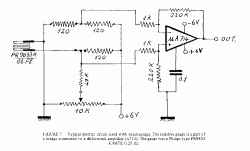 experimental setting is as indicated in Figure 6 and the amplifier circuits as in Figure 7. The use of strain gauges was initiated by us with this experiment (1975) and it has been widely employed in this kind of research, especially by J.B. Hasted. We can therefore omit a detailed description of such equipment.
experimental setting is as indicated in Figure 6 and the amplifier circuits as in Figure 7. The use of strain gauges was initiated by us with this experiment (1975) and it has been widely employed in this kind of research, especially by J.B. Hasted. We can therefore omit a detailed description of such equipment.
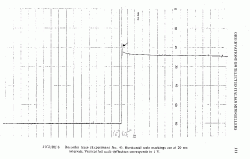 heartbeat), a symptom observed fairly often during experimentation with this subject. A.M. and the mother went out into the corridor where Orlando was, and the boy’s heart beat immediately went back to normal. A.M. went rapidly back to the room, where he saw that the recorder pen had shot off scale and then had gone back to a position different from the previous base line. In particular, the pen was drawing the part of the graph marked by the arrow in Figure 8. The meaning of the recorded curve is that the strip had first undergone an elastic deformation and then a permanent deformation. Indeed a bend of about 25 degrees was observed (Figure 9). The type of bending shown by the recording is certainly compatible with the mechanical properties of the material, which will undergo an elastic deformation first and a permanent one subsequently when acted upon by a suitable stress. A control trial effected by manually bending a
heartbeat), a symptom observed fairly often during experimentation with this subject. A.M. and the mother went out into the corridor where Orlando was, and the boy’s heart beat immediately went back to normal. A.M. went rapidly back to the room, where he saw that the recorder pen had shot off scale and then had gone back to a position different from the previous base line. In particular, the pen was drawing the part of the graph marked by the arrow in Figure 8. The meaning of the recorded curve is that the strip had first undergone an elastic deformation and then a permanent deformation. Indeed a bend of about 25 degrees was observed (Figure 9). The type of bending shown by the recording is certainly compatible with the mechanical properties of the material, which will undergo an elastic deformation first and a permanent one subsequently when acted upon by a suitable stress. A control trial effected by manually bending a 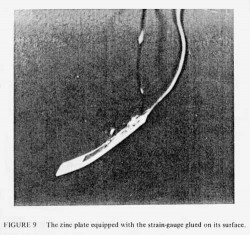 similar zinc plate gave rise to a graph very similar to the one which illustrates the supposed PK action. The time required by the pen to return to the original base line was in this case 20 seconds, as reckoned from the chart advancement rate, while the time required to perform the off scale shoot to the beginning of the elbow was circa 1.5 seconds (the off shoot being so sharp that the upward and downward branches are superimposed).
similar zinc plate gave rise to a graph very similar to the one which illustrates the supposed PK action. The time required by the pen to return to the original base line was in this case 20 seconds, as reckoned from the chart advancement rate, while the time required to perform the off scale shoot to the beginning of the elbow was circa 1.5 seconds (the off shoot being so sharp that the upward and downward branches are superimposed).From the above it can be deduced that, at the moment A.M. re-entered the room (finding the pen at the beginning of the elbow), not more than two seconds should have elapsed since the beginning of the essentially instantaneous deformation. This single calculation thus allows us to exclude any manipulation on the part of Orlando or of his mother.
From a physical point of view, the phenomenon could not be explained, in the sense that the origin of the force that brought it about was unknown, while the kind of bending monitored by the recorder was quite plausible for the material at hand.
The trial lasted 1 hour 50 minutes.
Comments of magicians
Magician A: On the basis of the description related to him, he could raise no objection regarding the reliability of the results.
Magician V.G.: On the basis of the description of the phenomenon, he only suggested that the event could have been random(!).
Experiment No. 5: Subject: Orlando Bragante (PE No. 85)
This experiment was carried out somewhat informally, yet the thermal effect was observed under good control conditions. Orlando had reported occasionally causing a considerable heating of metal objects he was trying to bend. While having dinner at Orlando’s house, the experimenter expressed some doubts regarding this observation of the boy and suggested it might have been just an impression. The boy took a spoon, held it in his fingers for a few seconds for everyone to see, then gave it to the experimenter who felt a sensation of high temperature. The spoon was burning hot at the point where the boy had held it. In this case, Orlando could not have produced the heat by bending and straightening the spoon in rapid succession, nor by using heat sources such as candles or lighters. The trial was repeated several times and the four persons present all noticed clearly the heating of the metal.
Comments of magicians
Magician A: He suggested that the use of chemical substances, such as mercury, could have been responsible for the 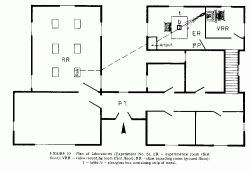 phenomenon, but this was excluded by the experimenters. He remarked that he could not offer any explanation, provided the use of other heat sources, such as candles and lighters was also impossible.
phenomenon, but this was excluded by the experimenters. He remarked that he could not offer any explanation, provided the use of other heat sources, such as candles and lighters was also impossible.
Magician V.G.: He suggested the boy could have utilized two 4.5V batteries, carrying them in his pockets, and having two wires going through his sleeves, connecting them to terminals placed on his fingers. As an example, he quoted a trick he used to perform, in which he caused a light electric shock in a person who, along with him, touched with his finger a coin placed on a table. He said, however, that in this performance he would wear gloves, and he thought it unlikely that the boy, sitting at the dinner table with a naked hand, could perform something as sophisticated as this
Experiment No. 6: Subject: Orlando Bragante (PE No. 95)
This experiment was carried out in the laboratory connected with the Medicina Radiotelescope, near Bologna. In Figure 10, a map of the laboratories is shown. The purpose was to perform a bending experiment under strictly controlled conditions, with strain gauge recording. The original project called for the subject to occupy an experimentation room (ER) where, on a table, there was a sealed plexiglass box containing a metallic strip sitting on a small U-shaped support and connected to a strain gauge, which in turn was connected, through a signal amplifier, to a chart recorder. The container was also originally controlled through a video-recorder, which allowed the subject to be left alone in the room. The plexiglass box was 180 X 110 X 110mm and its walls were glued with acrylic resin, except for one side, dovetailed to fit to the box, which was sealed with four lead seals with original impressions. The dovetailing was such that, after impressing the seals, nothing could possibly have been inserted into the box. Furthermore, a sealing tape was wound around the box and secured with sealing wax seals with original impressions.
The aluminium strip (70 X 10 X 2mm) was supported by a U-shaped plexiglass stand. One of the rest points was left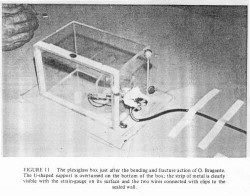 loose by carving a little indentation on the support and there was above it a piece of plaster.
loose by carving a little indentation on the support and there was above it a piece of plaster.
The strain gauge applied to the strip had its wires connected with clips to the sealed wall, where two contacts had been drilled to permit amplifier connection (Figure 11). The box was on the table and the external wires led to a locked amplifier situated in the same Experimentation Room. Finally, two screened cables connected the amplifier to a two-channel recorder on the lower floor (RR), the channels having sensitivities differing by a factor of ten. This recorded a quartz clock driven time signal every minute. The experimenters were assisted by colleagues and technicians (names available on request).
At 4 p.m. the trial started, and the boy, who was supposed to effect a bending of the plate, asked that the video control not be turned on during his first attempt. After trying for half an hour, Orlando asked to be able to hold the strip in his hand for a while, so he could ‘establish contact’ with the metal. The box was opened and, after ten minutes, was sealed once more, after an accurate inspection of the state of the specimen, which did not exhibit any sign of manipulation. Orlando was left alone in the ER while the experimenters went to a recording room (RR) on the lower floor. At 5.05 p.m. the boy went down to the RR, asked the experimenter to wait for him to return to the RR and to leave him alone in the ER even if a signal were to appear on the monitoring device. Then he returned upstairs and at 5.06 p.m. a remarkable signal appeared on the recorder. Two minutes later the boy came back and said that something had happened. Indeed, in ER the box was intact but the support inside was overturned and the strip nearly completely broken in two fragments, which were held together by the strain gauge (Figures 12, 13). The graphic recording (Figure 14) showed a series of very close negative and positive peaks, almost as if two invisible hands had alternately bent the strip this way and the other, for about two minutes, up to its moment of fracture.
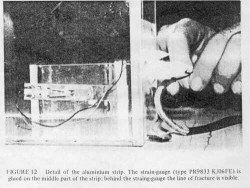 |
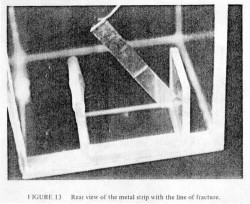 |
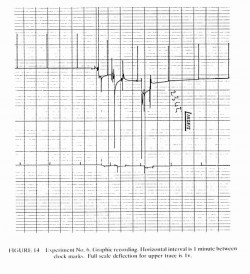 |
Even though the box was intact, and even admitting that it could have been shaken and then placed back on the table, this could have only explained the overturning of the support, but not the breaking of the strip. On the other hand, that the strip had been broken when Orlando had held it in his hands in order ‘to establish contact’ could be excluded, since the experimenter would have noticed when placing it back inside the box. On that occasion, some photographic pictures were taken so as to secure a witness of the phenomenon, but unfortunately none came out. Since the attention of the experimenters never slackened, it seems unlikely that a manipulation could have caught them unaware.
Comments of magicians
Magician A: After asking about the technical details of the experiments, he said that the only non-PK explanation was if the strip had been broken before being replaced in the box, without the experimenters noticing it. In that case, the support could easily have been overturned, and the recorder signals provoked by just shaking the box.
Magician V.B.: He did not consider it likely that the experimenters would not have noticed the strip being broken before replacing it. He was not too sure about the unfeasibility of opening the box without damaging the seals, but the experimenters did not agree with that. (The box is still intact, and may be inspected by anybody interested).
Experiment No. 7: Subject: Orlando Bragante (PE No. 106)
In this experiment, which was carried out in the house of the subject, the object was a zinc strip covered with putty and painted with aluminium paint, placed diagonally inside a sealed plexiglass box. The metal was thus sandwiched between two layers of putty. The metallization was meant to simulate a completely metallic object. Inside the he box, the little control cylinder device, illustrated in Experiment No. 1, was placed. The box was also weighed with a precision of 0.01gm. The purpose of this trial was to clarify the bending mode of the strip, i.e. the mechanism by which the supposed PK action took place on a macroscopic level. With this kind of sample, three hypotheses are possible. If we imagine, for the sake of simplicity, that the strip is resting horizontally with its ends on two supports, in order to bend it we could:
(1) Apply to the free ends forces exerted in a more or less uniformly distributed manner on the upper and lower surfaces, i.e. pressures exerted on the surface of the strip of manual bending type.
(2) Apply shearing forces parallel to the longitudinal axis, increasing in one sense when going from the neutral plane to the upper surface, and in an opposite sense going from the neutral plane to the lower surface, so that a lengthening of the fibres in the upper part and a shortening in the lower part results in bending.
(3) Apply a uniform force field, vertical for instance, which is exerted equally on all elements of the strip. This is what happens to a beam that is bent by its own weight because it is immersed in a gravitational field.
If we assume that the hypothetical PK force acts on the soft part in the same way as on the metallic part, in the first case we should expect to see in the putty the fruits of the pressure exerted. In the second case, we would also expect to find some effect on the putty. In the third case, there should not be any effect of differential deformation.
A similar sample (without the powders test control device, PE 99 – rated ++) previously given to Orlando, had shown a bending of the third type. This seemed to exclude a direct manipulation (made impossible, of course, by the box being sealed), but left open the possibility that as the strip leant on both extremities, it could have been acted upon by an inertial force due to a sudden downward motion of the box abruptly stopped. This was in principle possible, but many trials involving similar strips and identical containers, which were effected to verify the possibility of this occurrence, did not bring about the hypothesized result. The order of magnitude of deceleration obtained by muscle action (lowering motion and sudden arrest) proved insufficient to give rise to a permanent sizable deformation. The possibility that the boy might have utilized centrifugal forces is discussed below.
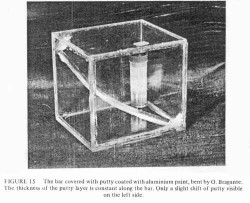 In the trial PE 106, he went to the living room all by himself, placed the box on the piano and started playing. At a certain point, he stopped, then he started playing again. After five minutes, he came back with the box, in which the strip was bent. The result confirmed that of PE 99, since the action manifested itself with modalities similar to inertial forces. No macroscopic deformation was detectable in the soft coating, and the thickness of the putty layer had remained constant except for an anomaly, viz. a slight shift outwards of one part only of the coat at one end (Figure 15).
In the trial PE 106, he went to the living room all by himself, placed the box on the piano and started playing. At a certain point, he stopped, then he started playing again. After five minutes, he came back with the box, in which the strip was bent. The result confirmed that of PE 99, since the action manifested itself with modalities similar to inertial forces. No macroscopic deformation was detectable in the soft coating, and the thickness of the putty layer had remained constant except for an anomaly, viz. a slight shift outwards of one part only of the coat at one end (Figure 15).
In this instance too, it appeared that the action had taken place as if a uniform force field had acted upon every material element of the strip. The powders in the cylinder were practically unstirred, which excluded the possibility that the box had been shaken. Since the walls were all glued in, its opening was also excluded. Finally, the possibility of obtaining a similar effect by means of rapid downward motion and abrupt stoppage which, in the presence of the mixing control, must have occurred in a perfectly vertical, jerk-free fashion, was excluded in view of the trials performed as explained above. The only reasonable alternative would have been centrifugal motion and the only device available to Orlando would have been the automatic washing-machine which, however, was located on a different floor of the house (reachable only by a trap door).
Trials were carried out with a similar strip placed in an identical container and inserted in a dishwashing machine in 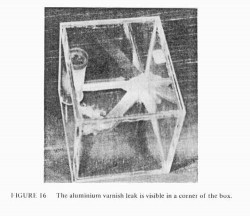 the absence of water, and in the presence of material suitable to keep the box in place. After ten minutes of centrifuging, the strip showed a deformation about one-third of the one produced by the boy. However, he could hardly have utilized it while playing the piano in the room upstairs. A positive rating therefore seems warranted, unless some incredible scheming and ability of the subject is assumed. One strange effect also occurred. After O.B. returned the box, for about half an hour the aluminium varnish leaked from the lower end of the strip on to the box floor (see Figure 16). Was this a testimony of a softening effect?
the absence of water, and in the presence of material suitable to keep the box in place. After ten minutes of centrifuging, the strip showed a deformation about one-third of the one produced by the boy. However, he could hardly have utilized it while playing the piano in the room upstairs. A positive rating therefore seems warranted, unless some incredible scheming and ability of the subject is assumed. One strange effect also occurred. After O.B. returned the box, for about half an hour the aluminium varnish leaked from the lower end of the strip on to the box floor (see Figure 16). Was this a testimony of a softening effect?
With the same sample as indicated in PE 106, Orlando performed another experiment, two days later, in which he again tried to bend the covered specimen. He asked to be left alone with the box for about fifteen minutes, saying that he needed that in order to concentrate, and came back with the box intact and the strip more thoroughly bent than before (PE 113).
In PE 99 the zinc strip dimensions were 105 X 10 X 2mm, those of the box were 90 X 75 X 55mm. The thickness of the putty coat was about 2mm on all sides. The box lid was sealed with acrylic resin.
In trial 106 the box dimensions were 95 X 85 X 80mm. The strip placed across the box bottom was 130 X 10 X 2mm. The thickness of the putty layer was 1 mm. The box was sealed with acrylic resin, and the weight of the box was controlled to within one centigram.
Comments of magicians
Magician A: He envisaged the possibility of the boy having prepared an identical sample beforehand or having stolen one from the experimenters, who denied such a possibility.
Magician V.B.: He judged the trial well planned and did not raise objections.
Experiment No. 8: Subject: Orlando Bragante (PE No. 114J
In this experiment, the aluminium strip was 60 X 15 X 1mm and had been suitably prepared, as others of this kind, in the Physics Institute of the University of Bologna, by treating it with a recrystallization process. The plexiglass container was identical to the ones already described, its length being such that the strip of metal lay on the bottom. This type of recrystallized aluminium strip was prepared in order to make an X-ray diffraction analysis afterwards to see the variation in size and distribution of crystalline grains. This can also be of use in obtaining some information about the problem of ‘softening’ in metal bending. As a comparison, we prepared a work-hardened strip of aluminium in order to watch, after bending, if some point of recrystallization appears.
The experiment was carried out in the subject’s home. In this instance, the bending occurred immediately after the 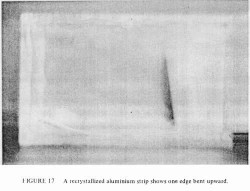 boy was given the sample, as if responding to an irritating stimulus with a fit of rebellion. Indeed, a disconcerting episode had just occurred, which aroused certain suspicions in the experimenters, and this in turn caused the boy to become upset. He scratched, with a cocky gesture, the sealed box containing, along with the cylinder device, a recrystallized aluminium strip (Figure 17) and left the dining room, where he returned after a few seconds, with the box intact and the strip bent on one side so that one of the edges was raised. Since the resting points were not the ends of the strip, such an effect would have been very difficult to contrive.
boy was given the sample, as if responding to an irritating stimulus with a fit of rebellion. Indeed, a disconcerting episode had just occurred, which aroused certain suspicions in the experimenters, and this in turn caused the boy to become upset. He scratched, with a cocky gesture, the sealed box containing, along with the cylinder device, a recrystallized aluminium strip (Figure 17) and left the dining room, where he returned after a few seconds, with the box intact and the strip bent on one side so that one of the edges was raised. Since the resting points were not the ends of the strip, such an effect would have been very difficult to contrive.
Countless attempts to reproduce manually this effect, carried out with similar samples, with and without the cylinder control device, never had any success. In the PK experiment, it might be added that no mixing inside the cylinder was noticed, even if the cylinder itself appeared slightly inclined. Also, the very short time in which the phenomenon occurred was remarkable.
Comments of magicians
Magician A: He could give no explanation, barring the opening or the substitution of the container.
Magician V.B.: He asked whether the boy knew beforehand the type of container utilized (he did), but did not offer any comments.
Experiment No. 9: Subject: Orlando Bragante (PE No. 103)
The results of this experiment, which was carried out in the home of the subject, were reminiscent of phenomena reported by other researchers. The task of Orlando was to bend a spoon enclosed in a sealed semi-rigid plastic jar. The spoon had been covered with rice wax, in order to detect any ‘prints’ that might appear on the waxy coating. The polyethylene semi-rigid jar was 120 X 60mm with a screw cap of 55mm, sealed with tape and sealing wax impressed seals. The spoon had been coated in advance by melting rice wax over it, which had a melting point between 780 C and 810 C. The jar was given to Orlando who held it for a few seconds, ten perhaps, the time necessary to open the door, go out into the entrance, reopen the door and come back with the sample perfectly sealed, but with the spoon clearly bent. A manipulation could be excluded due to the short time lapse. Furthermore, the wax had been removed from the end part of the handle, and had fallen to the bottom of the jar, so that the spoon was sticking in it and was standing vertical without leaning on the jar wall. When it was given back to the experimenter, the object was not particularly warm anywhere and showed no sign of thermal or mechanical alterations.
Comments of magicians
Magician A: He asked whether the jar was compressible (it was semi-rigid) and whether heating would produce the observed effect (it would not). He could not offer a valid explanation.
Experiment No. 10: Subject: Orlando Bragante (PE No. 118)
This experiment took place in the home of Orlando. It is an atypical kind of experiment, in that it recorded the occurrence of a luminous phenomenon, probably of electrostatic origin.
In previous experiments, it had appeared feasible that the boy could cause a light bulb to illuminate by simply holding it in his hand. During PE 118, before the experimenters proposed to verify this possibility under controlled conditions, the boy said the bulb as such had little importance, and he felt he could ‘turn on’ a bulb-shaped liquor bottle. The trial took place in the living room and during it the boy sat at the table and was constantly clearly visible to the experimenters since the room was lit. After about one hour, at a moment when both experimenters were looking toward the sitting subject, who was slightly bent forward, his arms resting on his knees under the table and his face at about 20cm from the liquor bottle, a very bright flash was seen above the bottle, which made the boy jerk. The experimenters had the feeling that the light did not come from under the table, but was localized between the bottle and Orlando’s face. The light was not as blinding as a magnesium flash and was different from that of an electric torch or of a flame. Before the experiment, all the photographic flashlights in the house had been set aside. An accurate scrutiny did not reveal anything suspicious about the boy or the room.
Comments of magicians
Magician A: He found odd the fact that the flashing had occurred right at the moment when one of the experimenters was re-entering the room. He suggested that at that moment a ‘misdirection’ might have occurred. In particular, he thought the boy could have produced the phenomenon by operating a magi-cube type of flash, but this was excluded by the controls effected, Also, the experimenters were not of the opinion that the light seen could have been simulated by a flash cube.
Magician VB: he suggested the use of a magi-cube or of a small flash bulb connected to a battery. The bulb could have been placed between the teeth and the trigger could have been operated with the tongue. After flashing, the small bulb could have been cooled with saliva and hidden under the tongue. The attenuation of the flash could be obtained with some enamel. The experimenters were of the opinion that such a device would have impaired the boy’s speech. Moreover, they had not seen the light come from his mouth, but from somewhere between his face and the bottle.
3. CONCLUSIONS
The experiments described above are only a small part of the total tests performed, but they show in a significant way the type of methods used and the results obtained. As has been seen, we often preferred to place the objects to be bent in sealed containers, in order to avoid direct hand contact and in order to avoid the necessity of the subjects being always under the strict invigilation of the experimenters.
The containers were generally made of plastic material, mainly plexiglass, often not standard, but made to specification. It is interesting to notice that we have also used objects (e.g. keys) within Pyrex glass tubes completely sealed with a torch, but no results were achieved. The subjects all justified their failure by saying that they were frightened by the possibility of the tube breaking. We also used strain gauges as have other experimenters (e.g. Hasted, 1976; Isaacs, 1981), but for the purpose of clarifying the dynamics of bending rather than revealing micro-bending effects.
The experiments described show that the authenticity of the paranormal action seems in most cases highly likely, as many of these experiments were performed under good controls. Nevertheless, we have to admit that it is very difficult to bring about a truly crucial experiment. By ‘crucial experiment’, we mean the kind of experiment in which it is not possible to admit any possibility of manipulation or trickery. Often, during well planned experiments, at some points in the chain of events leading to the result, control was lost; a typical example is seen in experiment No. 6, in which O.B. requested the video recording to be turned off; another was the failure in photographic control – it is ironic that this failure was not due to the subject but to the experimenters (for no clear reasons). In such circumstances, the experiment has to be considered as very good, but certainly not totally satisfactory.
This kind of situation is quite common in macro-PK experiments, and would require further discussion beyond the scope of the present paper. Another feature of these phenomena is their tendency to avoid direct observation. Only on rare occasions did we have the opportunity directly to observe the bending event, and perhaps not in the best of conditions.
As far as the magicians’ opinions are concerned, it must be noted that these were based only on an accurate description of the experiments performed, as they were not present during the experimental sessions. Clearly, it appears that their speculations about a possible fraud are often more theoretical than practicable, because some of the suggested tricks require a very sophisticated technique and suitable means to be available; but we have found it interesting to submit our experiments to tricks experts just to see if our methods were reliable enough. Nevertheless, we consider the problem of fraud very important, and we were advised of possible tricks which warrant a deeper discussion.
Taking the above considerations into account, it seems a little difficult to draw general conclusions from the experiments here described, and from all our observations, because each of them is subject to a different degree of reliability.
We shall, however, accept as genuinely paranormal the experiments classified as good ( +++ ) and thus summarize the main results as follows:
(a) Paranormal bending (or fracture) is possible not only with metal objects, but also with non-metal ones (e.g. plastics).
(b) The characteristics of the bend signals, as monitored by strain gauges, do not look different from a normal bending, as could be obtained by hands or other physical means. Nevertheless, this result does not contradict those of Hasted (1976, 1977, 1980, 1981) and Isaacs (1981), who found signals too fast to be due to a muscular action, because our monitoring system was too slow to detect time intervals smaller than 0.1-1 sec.
(c) The observations of strips covered with soft material seem to indicate that the bending action was very similar to a uniform field of force acting upon all points of the strips, rather than a pressure applied on the surface of the specimen or a distribution of stresses acting along its length.
(d) We observed thermal and softening effects, but we were not able to determine whether or not such effects could be related to the bending itself as proposed by Hasted in some instances (1981, p. 111). An indirect indication could be the softening of the varnish in experiment No. 7 on the covered zinc strip, but no definite conclusion can be drawn. Nor have we obtained certain indications by strain gauge signals. For example, in experiment No. 4, the signal reveals an elastic component followed by a plastic deformation, just as we should expect from the nature of the material used.
(e) No clear effects have been revealed that were inconsistent with the nature of the material employed. For example, we attempted to obtain bending with brittle materials, but we only obtained fractures. When we analyzed (by X-ray diffraction and microscope techniques) the aluminium specimens specially prepared to observe any effects on the microcrystal grains, no significant results were obtained, and some interesting differences between specimens treated by the subjects and by hands were below a level of true statistical significance. Similar experiments have recently been performed by Scutt (1981), who has obtained some interesting but non-conclusive results about a possible difference between mechanical bending and Paranormal bending. Other tests were performed on a key and a ring which had been broken, but they will be considered in another publication.
(f) We observed some light flashes which could have been due to some paranormal electric phenomenon of a type very similar to that investigated by Hasted (1981).
(g) In some instances, the bending seemed intentionally directed, as in the ‘puppet’ case (experiment No. 1). This is rather exceptional, because generally the PK action does not appear to be under precise control of consciousness. It seems, rather, that a conscious decision may catalyze an unconscious activity.
Acknowledgments
The authors are gratefully indebted to the subjects and to their families. They are also greatly indebted to Dr. P. Cassoli, Dr. A. Peduto, Dr. A. Bononcini, Dr. G. Plicchi, Dr. R. Zannoli, and to colleagues of the Physics Department, University of Bologna and of the CSP, for their help and criticism.
References
Hasted, J.B. An experimental study of the validity of metal-bending phenomena. J. Soc. Psych. Res., 48, 365-383, 1976.
Hasted, J.B. Physical aspects of paranormal metal-bending. J. Soc. Psych. Res., 49, 583-607, 1977.
Hasted, J.B. Speculations about the relation between psychic phenomena and physics. Psychoenergetic Sys., 1, 1-15, 1978.
Hasted, J.B., Robertson, D. Paranormal action on metal and its surroundings. J. Soc. Psych. Res., 50, 379-398, 1980.
Hasted, J.B. The Metal-Benders, Routledge and Kegan Paul, London, 1981.
Hasted, J.B., Robertson, D. Paranormal electrical effects. J. Psychophys. Sys., 4, 169-187, 1981.
Isaacs, J. Psychokinetic Metal-Bending. PSI News, 4, 1981.
Scutt, D.C. An investigation into metal bending ‘Geller effect’ with Ori Svoray, J. Soc, Psych. Res., 51, 1-6, 1981.
Shafer, M.G. PK metal bending in a semi-formal small group. Parapsychological Association, 23rd annual convention. Programme of research papers and symposia, 74-93, Reykjavik, Iceland, 1980.
Taylor, J.G. Superminds. An Analysis of the Geller Effect, London, Macmillan, 1975.


Latest Articles
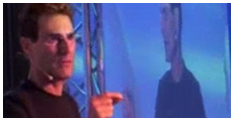
Motivational Inspirational Speaker
Motivational, inspirational, empowering compelling 'infotainment' which leaves the audience amazed, mesmerized, motivated, enthusiastic, revitalised and with a much improved positive mental attitude, state of mind & self-belief.



















